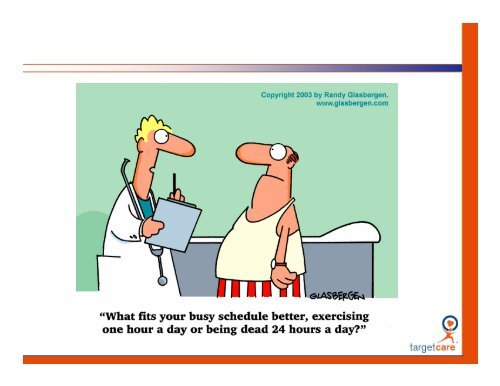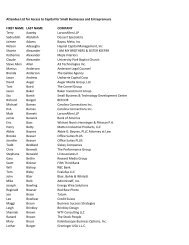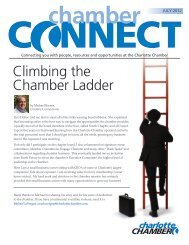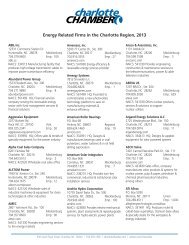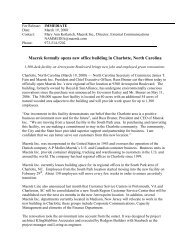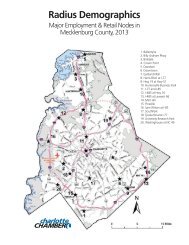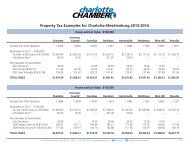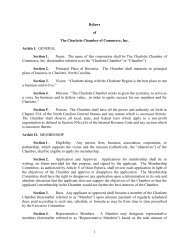Health and Wellness Benefits - Charlotte Chamber of Commerce
Health and Wellness Benefits - Charlotte Chamber of Commerce
Health and Wellness Benefits - Charlotte Chamber of Commerce
You also want an ePaper? Increase the reach of your titles
YUMPU automatically turns print PDFs into web optimized ePapers that Google loves.
<strong>Health</strong> <strong>and</strong> <strong>Wellness</strong> <strong>Benefits</strong>:<br />
Do They Really Impact<br />
the Bottom Line?
What is Worksite <strong>Wellness</strong>?<br />
<br />
An organized program at the worksite<br />
designed to target particular health risk<br />
factors that are modifiable <strong>and</strong> associated<br />
with particular kinds <strong>of</strong> illness (chronic<br />
disease). This type <strong>of</strong> program is intended<br />
to assist employees <strong>and</strong> their family<br />
members (<strong>and</strong>/or retirees) in making<br />
voluntary behavior changes.<br />
Source: WELCOA<br />
93% <strong>of</strong> companies invested in some type <strong>of</strong> wellness program in<br />
2009, up from 88% in 2008 (Kaiser Family Foundation).
Current <strong>Health</strong>care Environment<br />
Really, a “sick care” system. Best<br />
quality sick care in the world.<br />
Driven by a “reactive” approach.<br />
• Physicians practice reactive medicine.<br />
• Employers react to rising costs by changing<br />
plan designs, Carriers/TPA’s, etc. creating an<br />
environment <strong>of</strong> constant change.<br />
• Employees react to rising costs by avoiding<br />
timely treatment, <strong>and</strong> taking less<br />
responsibility for their own behavior.
Pro-active Approach<br />
The “reactive” approach misses the target <strong>and</strong><br />
leads to further disconnect between the<br />
healthcare providers, employers (payers) <strong>and</strong><br />
employees (consumers) <strong>of</strong> medical services.<br />
A “proactive” approach identifies individuals at risk<br />
before they incur claims, preventing explosive costs<br />
associated with chronic disease onset.
Why invest in a wellness program?<br />
Can you afford not to?<br />
If food prices had risen the same rate as medical inflation since the<br />
1930’s, we would be paying…..<br />
1dz Eggs $ 80.20<br />
1lb Apples $ 12.23<br />
1lb Sugar $ 13.70<br />
1 roll Toilet Paper $ 24.20<br />
1dz Oranges $107.90<br />
1lb Butter $102.07<br />
1lb Bananas $ 16.04<br />
1lb Bacon $122.48<br />
1lb C<strong>of</strong>fee $ 64.17<br />
1lb Beef $ 43.57<br />
_________________________________________________________<br />
10 Item Total $586.56<br />
Source: American Institute for Preventive Medicine, 2007
Why Invest in a <strong>Wellness</strong> Program?<br />
Chronic Diseases are COSTLY!!!!<br />
<br />
<br />
<br />
<br />
<br />
Average annual healthcare expenditures for a diabetic<br />
participant are $18,000 compared to $4,000 for a nondiabetic.<br />
20.8 million Americans have diabetes <strong>and</strong><br />
6.2 million <strong>of</strong> those are undiagnosed.<br />
By 2015, annual per capita healthcare<br />
expenditures will exceed $15,000.<br />
65 million Americans have hypertension, a number that<br />
grows almost 2% a year<br />
Smokers cost $3,400 per year, $1,623 on excess medical<br />
costs <strong>and</strong> $1,760 on lost productivity.
Why Implement a <strong>Wellness</strong> Program?<br />
To reduce rising healthcare costs<br />
To reduce an employee’s modifiable risk factors <strong>and</strong><br />
lower their chances <strong>of</strong> developing a chronic disease<br />
To keep healthy employees healthy<br />
Reduce workplace injuries<br />
Improve productivity, improve morale <strong>and</strong> reduce<br />
absenteeism<br />
To reduce sick leave<br />
Improve health consumer skills
The two major steps to implementing<br />
worksite wellness…..<br />
Step 1: Assessment<br />
<strong>Health</strong> Risk Assessment (HRA) ~ Identify personal<br />
lifestyle factors, many different varieties (selfreported)<br />
BioMetric Measures ~ venipuncture vs. Cholestech<br />
Reporting to individuals <strong>and</strong> employer: does it assess<br />
<strong>and</strong> quantify health risk<br />
Step 2: Intervention
<strong>Health</strong> Risk Assessments<br />
Questionnaires<br />
Self-Reported Information<br />
Length<br />
Results
Biometric Measures<br />
Cholestech- Finger Prick<br />
Venipuncture- Arm Draw<br />
Labs to include in testing<br />
Physician thoughts
Reporting<br />
Decision on what you are hoping to gain<br />
from this assessment.<br />
Individual – What do you want<br />
employees to walk away knowing after<br />
their assessment?<br />
Aggregate- What type <strong>of</strong> data are you<br />
looking to collect on your employees?
Step 2 in Worksite <strong>Wellness</strong>…..<br />
Step 2: Intervention<br />
Intervention programs depend on the size <strong>of</strong><br />
the employer<br />
Smaller employers will more likely keep their<br />
programs simple in design <strong>and</strong> <strong>of</strong>fer only one<br />
topic at a time<br />
Larger employers will provide a more complex<br />
intervention <strong>and</strong> <strong>of</strong>fer a more comprehensive<br />
menu <strong>of</strong> choices
Intervention Options…..<br />
Group Lunch <strong>and</strong> Learns<br />
Face-to-Face <strong>Health</strong><br />
Coaching<br />
On-site Clinics<br />
Tobacco Cessation<br />
Disease Specific Programs<br />
Gym Memberships<br />
Telephonic <strong>Health</strong><br />
Coaching<br />
Worksite challenges<br />
(biggest loser, etc)<br />
Walking Programs<br />
Worksite Exercise Classes<br />
Stress Management<br />
Carrier Disease<br />
Management Programs
Three Levels <strong>of</strong> Intervention Programs<br />
1. Level One: Quality <strong>of</strong> Work Life<br />
This type <strong>of</strong> program is morale building, least expensive to<br />
implement (under $50) <strong>and</strong> provides the least ROI.<br />
2. Level Two: Traditional Programming<br />
This type <strong>of</strong> program has an emphasis on biometric measures,<br />
minimal use <strong>of</strong> incentives, expect to spend $50 to $150 PEPY,<br />
ROI expected around $1.50 to $3.50 per dollar invested.<br />
3. Level Three: <strong>Health</strong> <strong>and</strong> Productivity<br />
Management<br />
Begin collecting data that is quantifiable, link wellness to employee<br />
benefits, largest investment (up to $450 PEPY, ROI expected around<br />
$3.6 to $7.0 per dollar invested.<br />
Source: Larry Chapman, Summex <strong>Health</strong> Management
Evaluation:<br />
Survey- Employee Feedback<br />
Data<br />
Absenteeism & Presenteeism<br />
Morale<br />
Culture<br />
Medical Claims & Utilization<br />
Turnover<br />
Workers Compensation<br />
Disability
Survey<br />
Surveying the employees allows you to<br />
develop programs based upon their<br />
needs (not what you think they need).<br />
Helps gauge motivation <strong>and</strong> participation<br />
levels.<br />
Illustrates the changes over time in<br />
employee satisfaction in regards to the<br />
programs <strong>and</strong> measures changes in<br />
behavior.
Why Collecting Data is Important<br />
Allows you to communicate why a<br />
program is important.<br />
Allows senior level executives <strong>and</strong><br />
management to underst<strong>and</strong> the health<br />
<strong>and</strong> risk factors <strong>of</strong> the employees.<br />
Allows the employees to underst<strong>and</strong> the<br />
health <strong>of</strong> the population.<br />
Allows you to measure change which will<br />
show the value <strong>of</strong> the program.
Absenteeism & Presenteeism<br />
Definition <strong>of</strong> Absenteeism- Amount <strong>of</strong> time<br />
employees are paid while not at work.<br />
Braun Consulting places absenteeism in three buckets.<br />
1. Authorized (approved)<br />
2. Legal (public holidays)<br />
3. Unauthorized (what organizations strive<br />
to avoid <strong>and</strong> measure)<br />
Presenteeism – the amount <strong>of</strong> time employees are at<br />
work but not really working<br />
Beginning to be a significant employer cost <strong>and</strong> is gaining<br />
credibility among employers<br />
The problem with presenteeism is that the effects exist long before<br />
employees become absent.
Absenteeism & Presenteeism- The<br />
Bottom Line<br />
According to the US Bureau <strong>of</strong> Labor Statistics:<br />
Of all expenses related to absence, unscheduled<br />
time <strong>of</strong>f has the biggest impact on productivity,<br />
pr<strong>of</strong>itability <strong>and</strong> morale. Companies lose an<br />
approximate 2.8 Million workdays each year<br />
because <strong>of</strong> employee injuries <strong>and</strong> illness.
Absenteeism & Presenteeism- The<br />
Bottom Line (continued)<br />
Top Ten Most Costly <strong>Health</strong> Conditions<br />
Condition<br />
Hypertension<br />
Heart Disease<br />
Depression<br />
Arthritis<br />
Allergies<br />
Diabetes<br />
Migraines<br />
Cancer<br />
Respiratory Infections<br />
Asthma<br />
Goetzel, R.,. JOEM, 45 (1):5-14. 2003<br />
Rank<br />
1<br />
2<br />
3<br />
4<br />
5<br />
6<br />
7<br />
8<br />
9<br />
10<br />
Total cost Using average presenteeism<br />
estimate per ee/per year<br />
$392.31<br />
$368.34<br />
$348.04<br />
$326.88<br />
$271.04<br />
$256.91<br />
$213.78<br />
$144.01<br />
$133.84<br />
$99.55
Morale<br />
Most underestimated measure in a<br />
wellness program.<br />
Enhances loyalty to the organization.<br />
Great retention <strong>and</strong> recruitment tool.<br />
Employees do not leave companies<br />
because <strong>of</strong> money, they leave because<br />
they do not feel appreciated.
Culture<br />
Cultural assessment should include…..<br />
» <strong>Health</strong>y cafeteria/ vending machine<br />
options<br />
» Opportunities for physical activity at the<br />
work-site<br />
» <strong>Health</strong>y food choices at company parties<br />
» Bulletin boards with educational<br />
information<br />
» Presentations <strong>and</strong>/or education on<br />
healthy eating<br />
» <strong>Health</strong> related break stations (i.e. blood<br />
pressure checks, glucose, etc.)<br />
» Tobacco Free work-place
Medical Claims <strong>and</strong> Utilization<br />
Overall Medical Claims <strong>and</strong> Expenses<br />
Emergency Room usage versus Urgent<br />
Care<br />
Primary Care visits<br />
Labs<br />
Medication Compliance<br />
Length <strong>of</strong> Hospital Stays <strong>and</strong><br />
Admissions<br />
Risk changes
Workers Compensation/ Disability &<br />
Turnover<br />
<strong>Health</strong>ier employees are less likely to<br />
injure themselves on the job, <strong>and</strong> if<br />
injured, they have a quicker recovery<br />
time.<br />
<strong>Health</strong>ier employees have shorter<br />
disability lengths <strong>and</strong> fewer claims for<br />
chronic illness.<br />
Minimize turnover due to retention <strong>of</strong><br />
healthy employees.
Keys to a Successful <strong>Wellness</strong> Program<br />
Strong C-Suite, Senior <strong>and</strong> Mid-level<br />
management support<br />
Programming that allows for measurable<br />
changes in risks<br />
Positive Communication<br />
Programs that employees need <strong>and</strong> want<br />
Well paced programming<br />
Effective use <strong>of</strong> incentives
Incentives<br />
Gift cards<br />
Trinkets<br />
Paid Time Off<br />
Party<br />
Management Incentives<br />
Workout Gear<br />
Raffle Prize<br />
Points-Based Incentives<br />
Cash<br />
Discount on Insurance Premium<br />
Deposits: Many employers today are making deposits<br />
into a <strong>Health</strong> Savings, <strong>Health</strong> Reimbursement <strong>and</strong><br />
Flexible Spending Accounts, along with creating<br />
<strong>Health</strong> Incentive Accounts. Typically deposit accounts<br />
are criteria-based programs
Rewards <strong>of</strong> <strong>Wellness</strong> Programs<br />
Rewards for the community:<br />
Programs contribute to establishing good health in the community<br />
Reinforces national <strong>and</strong> local public health initiatives<br />
Improves quality <strong>of</strong> life<br />
Rewards for Employees:<br />
<br />
<br />
<br />
Increased health literacy<br />
Increased knowledge about the relationship between lifestyles <strong>and</strong><br />
health<br />
Improved control over health<br />
Rewards for the Employer:<br />
Many economic rewards<br />
Provides a model for other organizations<br />
Good PR
RESOURCES:<br />
WELCOA<br />
Vendors<br />
Mecklenburg County: Fit City<br />
CDC<br />
The Employers Association


